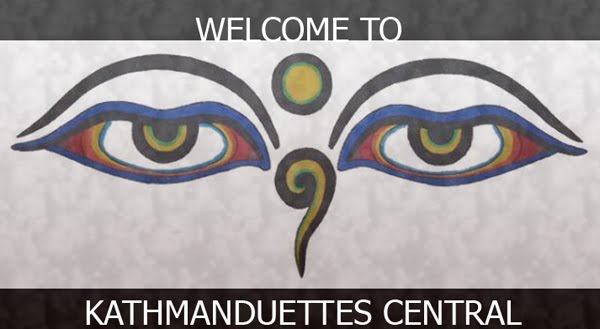
 Kosi Compound was built by Indians who resided there in the 'fifties while doing work on the Kosi River. It is located in Dilli Bazaar, not so far from Alice and Ed Perdon’s residence. There were a number of two-storey houses, the front large one became the Tax Office, while the one on the left as you come in through the gate with the brass plaque that reads “Himalayan Trust Fund” is Elizabeth Hawley’s residence on the upper floor, and the Fund’s rooms, residential and offices, on the ground floor. She was the person on the spot on behalf of Sir Edmund Hillary's Himalayan Trust Fund.
Kosi Compound was built by Indians who resided there in the 'fifties while doing work on the Kosi River. It is located in Dilli Bazaar, not so far from Alice and Ed Perdon’s residence. There were a number of two-storey houses, the front large one became the Tax Office, while the one on the left as you come in through the gate with the brass plaque that reads “Himalayan Trust Fund” is Elizabeth Hawley’s residence on the upper floor, and the Fund’s rooms, residential and offices, on the ground floor. She was the person on the spot on behalf of Sir Edmund Hillary's Himalayan Trust Fund.A blue VW is usually parked next to the house, the trusty car of Ms Hawley. The grounds were always abuzz with sherpa baskets, construction material, cartons of medical supplies, and people coming and going, backpacks filled to the brim. We occupied the house just behind the Tax Office, and is named Shanti Niketan, “Peace House”, our residence for ten years in Kathmandu. We had the lower floor with two bedrooms, while VK Shrestha, RNAC pilot and his family, had the upper floor. The Bhandary brothers and their families, Prabhu and Rajan, our landlords, occupied the other two houses. Within the compound, a number of dogs could be seen scampering about at any time. However, the Hawley Lhasa Apso was always let out with a leash by its Ayah, always immaculately brushed.
The most celebrated mountaineer who was an occasional visitor was Sir Edmund Hillary, and could be seen supervising the porters or counting boxes or rolls of wire or bags of cement, for transport to the Trust-supported Khunjung School and Khunde Hospital at Namche Bazaar, or briefing medical volunteers from Australia or New Zealand who would spend time at the school or hospital. The nearest airport there would be at Lukla, where an RNAC pilot friend of ours had supplied us with pine to use as a Christmas tree one winter.
While we were in Seattle last summer, I stumbled across a reference to Elizabeth Hawley’s bio, called “I’ll Call You in Kathmandu”. We wasted no time to go to Barnes and Noble to obtain a copy but we were told it was out of print. A couple of days later I came across the address of its publisher in downtown Seattle which specializes in mountaineering topics, and they were able to mail us a copy.
Here are some excerpts of reviews:
One of the most important figures in Himalayan climbing may be someone who has never been to Everest Base Camp, and is not a climber. In 1960, a young American woman, Elizabeth Hawley, moved to Nepal as a reporter for Time, Inc. Initially sending home political dispatches from the kingdom, it wasn’t long before Hawley’s pen found its niche: mountaineering in the world’s highest places. She quickly became part of the Kathmandu scene, socializing regularly with an eclectic group of adventurers, climbers, royalty, politicians and entrepreneurs. Hawley is still in Kathmandu today and has been the unofficial chronicler of every detail of every expedition mounted from Nepal in the Himalaya from more than four decades.
She was born in 1923 in Chicago and has made her fame as the chronicle of Himalayan expeditions. She is respected by the international mountaineering community because of her complete and accurate records, despite their being unofficial.
What would motivate this single American woman, the product of a Midwest upbringing, to travel solo during this era to one of the most remote and enigmatic places on the globe? How did she command the respect of climbers from around the world (some of whom report fear of her sharp tongue and rigorous interview style)? How did she remain an authoritative figure for 40 years during the most intense climbing of this region—the “Golden Era of Himalayan Climbing”? What changes did she see take place in mountaineering and in the political landscape of this region?
Although the intensely private Ms. Hawley is an enigma even to those who know her well, I’ll Call you in Kathmandu reveals Hawley as a complex personality, with a rich personal life.
Climbers who want to be recognized for climbing Everest subject themselves to interviews with her. Her archives have been compiled into two reference works: The Himalayan Database and The Himalaya By the Numbers.
In 2008, a newly climbed peak was named after her. Peak Hawley (6,182m/20,282') in the Dhaulagiri Group by the French climber Francois Damilano.
( Photo found in: http://www.climbing.com/news/hotflashes/newly_climbed_peak_named_for_elizabeth_hawley/)

